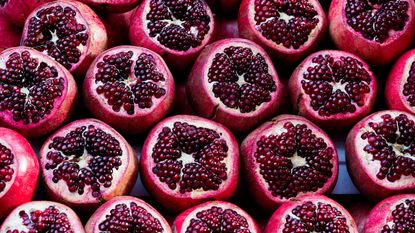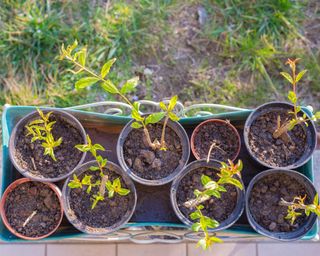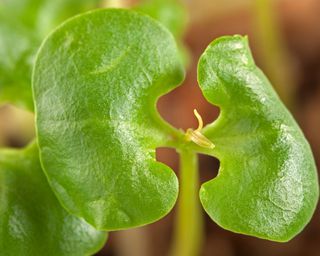Can you grow a pomegranate tree from seed? Experts reveal how to get the best results
Find out how to grow pomegranates from seed and you'll soon be growing your own delicious fruit


If you're wondering how to grow pomegranates from seed, you'll be pleased to know it's really straightforward as well as being a great way to produce your own healthy, tasty fruit. Once you get the hang of it you'll be wondering why you've never grown pomegranate seeds before.
With their delicious sweet-sharp juice and dark red jewel-like seeds, exotic pomegranate trees are easy to care for and produce a bountiful harvest of fruit. Although associated with warm climates, pomegranates are surprisingly hardy, tolerating temperatures down to 5˚F (-15˚C) when grown in a sheltered position.
So if you're looking for a fun way to grow your own and interested in the best fruit trees to choose, it can be worth giving pomegranates a go.

Homegrown pomegranates are a delicious alternative to picking up fruit at the store
Expert tips on how to grow pomegranates from seed
Next time you tuck into a delicious pomegranate fruit why not keep the seeds? Then you can add them to your kitchen garden for an easy and economical way to grow your own tasty fruit.
Follow this simple step-by-step guide.
1. Get the pomegranate seeds out of the fruit

The first step is to choose a plump and healthy looking pomegranate and get the seeds out of the fruit. 'This can be tricky,' says Zeeshan Haider, CEO and founder of GreenryEnthusiast.com. 'While you may be tempted to cut open the pomegranate and simply take the seeds out, this is not the best option. Instead, you should use a spoon or other kitchen tool to gently separate the seeds from the pulp.'
First roll the pomegranate to loosen the seeds. Score around the middle and tear it open into halves. Take care not to cut into the seeds. Hold each half over a bowl, seeds facing down and tap the skin with a wooden spoon, squeezing a little to release the seeds.
Or try this hack. Score four lines from top to bottom to quarter the pomegranate. Submerge it into a bowl of water and and pull apart the quarters, scooping the seeds out with your fingers. The pith will float and the seeds will sink. Remove the pith and discard, then drain the seeds.
2. Prep the pomegranate seeds

Once you have separated the seeds rinse them in cold water. You can skip this step if you used the bowl method. This will help to remove any remaining bits of pulp and make sure that the seeds are squeaky clean. Be sure to remove all the pulp or fungus might grow on your seeds.
You will be left with small white seeds once the rosy flesh that surrounds them has been removed. Once rinsed, spread the pomegranate seeds on a baking sheet covered with a layer of paper towels and leave them to dry. This step is important, as it gives the seeds time to create a protective coating. Place the baking sheet in a cool, dry area and allow the seeds to dry for several days, or until they are completely dry.
Once the seeds are dry, they're ready to be planted. Select only plump and healthy looking seeds.
3. Plant the pomegranate seeds

For best results, start pomegranate seeds indoors in midwinter, so they have a couple of months headstart before spring planting season. You'll need some pots or starter cells, compost such as a lightweight, seed-starting potting soil, and your pomegranate seeds.
Pour some soil into each pot or starter cell and spread it evenly. Plant seeds on top of the soil. Make sure that you bury them about one-third of an inch deep, then cover with a light layer of soil. Make sure the seeds are moist but not wet and place in a warm, sunny location. You can add plastic bags to create a DIY mini greenhouse effect too. Make sure you water your seeds regularly.
4. Transfer the seedlings outdoors
Seeds take between 1-6 weeks to germinate, depending on the growing conditions. When the pomegranate seeds start to sprout, thin out any of the less vigorous seedlings then start to think about transferring the plants outdoors. Do this in stages to progressively harden off plants as the weather warms up.
You can either plant your pomegranates seedlings in the ground, or if you prefer growing fruit in pots you can plant them in a container and grow them on your patio.

Transfer young pomegranate plants outdoors gradually to harden them off
What is the wet towel method for propagating pomegranate seeds?
There is another way to propagate pomegranate seeds that is known as the wet towel method. Horticulturalist Brody Hall of The Indoor Nursery explains how to use this alternative method.
- Use a spray bottle or mister to soak a clean paper towel with water.
- Wrap the pomegranate seeds in the damp paper towel and place the seeds in a ziplock bag. Blow a little air into it then seal the bag.
- Store the bag of seeds in a warm, dark place, such as a kitchen cupboard, for 5-7 days.
- Check the seeds daily. If the paper towel starts to dry, re-moisten it with water.
- When the seeds have sprouted (around 7-10 days), prepare several pots of potting soil. Use a pencil to make planting holes and gently place the sprouted seeds into the soil.
- Cover the seeds with a thin layer of soil and lightly water them in.
- Place the pot in a sunny, warm spot and water regularly. The soil should remain damp but not soggy.
- After about two weeks you should have seedlings about an inch tall that can be moved outside or to bigger pots.

The leaf of a pomegranate seedling
How long does it take to get fruit from a pomegranate seedling?
This depends on your climate and the planting position, as well as how big the plants are when they go in to the ground. Don't forget that pomegranates are one of the best fruit trees to grow in pots too, so you may prefer to plant them in containers.
Generally pomegranate trees will produce a reliable harvest two to three years after planting if their growth has been hearty, but trees don’t start to fruit heavily until after five years or so. They also need a long, hot, dry summer for the fruit to ripen, so make sure you plant them in a spot where they will get plenty of sun.

Gardening Etc Newsletter
The Home Of Outdoor Living

Lifestyle journalist Sarah Wilson has been writing about gardens since 2015. She's written for Gardeningetc.com, Livingetc, Homes & Gardens, Easy Gardens and Modern Gardens magazines. Having studied introductory garden and landscape design, she is currently putting the skills learned to good use in her own space where the dream is establishing a cutting garden.
-
 An Update on Gardeningetc
An Update on GardeningetcA word from our publisher
By Beth Murton Published
-
 Take part in the RSPB’s Big Garden Birdwatch 2023 to save our feathered friends
Take part in the RSPB’s Big Garden Birdwatch 2023 to save our feathered friendsGardens Watching garden visitors for just one hour in the Big Garden Birdwatch 2023 could help provide vital data to protect birds from the effects of climate change
By Jayne Dowle Published